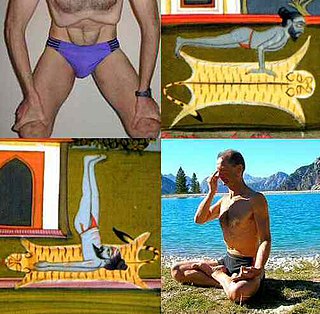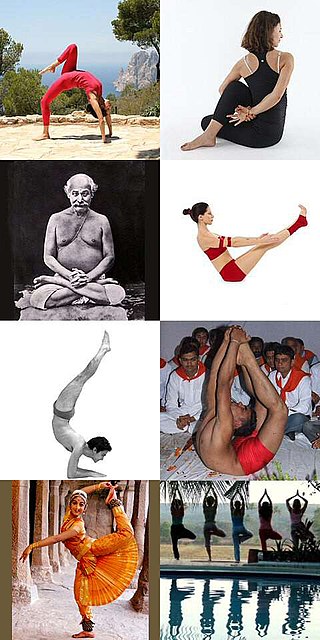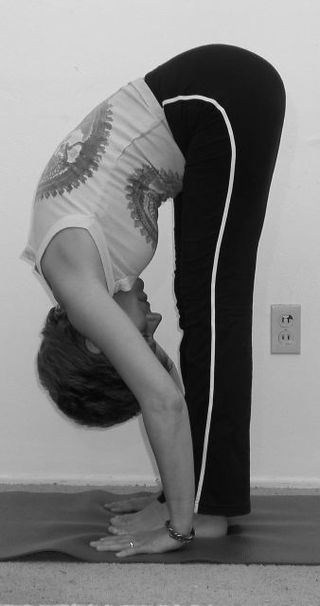In yoga, Ayurveda, and Indian martial arts, prana permeates reality on all levels including inanimate objects. In Hindu literature, prāṇa is sometimes described as originating from the Sun and connecting the elements.

Hatha yoga is a branch of yoga that uses physical techniques to try to preserve and channel vital force or energy. The Sanskrit word हठ haṭha literally means "force", alluding to a system of physical techniques. Some hatha yoga style techniques can be traced back at least to the 1st-century CE, in texts such as the Hindu Sanskrit epics and Buddhism's Pali canon. The oldest dated text so far found to describe hatha yoga, the 11th-century Amṛtasiddhi, comes from a tantric Buddhist milieu. The oldest texts to use the terminology of hatha are also Vajrayana Buddhist. Hindu hatha yoga texts appear from the 11th century onward.

Ashtanga vinyasa yoga is a style of yoga as exercise popularised by K. Pattabhi Jois during the twentieth century, often promoted as a dynamic form of classical Indian (hatha) yoga. Jois claimed to have learnt the system from his teacher Tirumalai Krishnamacharya. The style is energetic, synchronising breath with movements. The individual poses (asanas) are linked by flowing movements (vinyasas).

An āsana is a body posture, originally and still a general term for a sitting meditation pose, and later extended in hatha yoga and modern yoga as exercise, to any type of position, adding reclining, standing, inverted, twisting, and balancing poses. The Yoga Sutras of Patanjali define "asana" as "[a position that] is steady and comfortable". Patanjali mentions the ability to sit for extended periods as one of the eight limbs of his system. Asanas are also called yoga poses or yoga postures in English.

Pranayama is the yogic practice of focusing on breath. In yoga, breath is associated with prana, thus, pranayama is a means to elevate the prana-shakti, or life energies. Pranayama is described in Hindu texts such as the Bhagavad Gita and the Yoga Sutras of Patanjali. Later in Hatha yoga texts, it meant the complete suspension of breathing. The pranayama practices in modern yoga as exercise are unlike those of the Hatha yoga tradition.
Pratyahara or the 'gathering towards' is the fifth element among the Eight stages of Patanjali's Ashtanga Yoga, as mentioned in his classical work, Yoga Sutras of Patanjali composed in the 2nd century BCE. It is also the first stage of the six-branch yoga (ṣaḍaṅgayoga) of the Buddhist Kālacakra tantra, where it refers to the withdrawal of the five senses from external objects to be replaced by the mentally created senses of an enlightened deity. This phase is roughly analogous to the physical isolation phase of Guhyasamāja tantra.

Sun Salutation, also called Surya Namaskar or Salute to the Sun, is a practice in yoga as exercise incorporating a flow sequence of some twelve linked asanas. The asana sequence was first recorded as yoga in the early 20th century, though similar exercises were in use in India before that, for example among wrestlers. The basic sequence involves moving from a standing position into Downward and Upward Dog poses and then back to the standing position, but many variations are possible. The set of 12 asanas is dedicated to the Hindu solar deity, Surya. In some Indian traditions, the positions are each associated with a different mantra.

Uttanasana or Standing Forward Bend, with variants such as Padahastasana where the toes are grasped, is a standing forward bending asana in modern yoga as exercise.

Kumbhaka is the retention of the breath in the yoga practice of pranayama. It has two types, accompanied whether after inhalation or after exhalation, and, the ultimate aim, unaccompanied. That state is kevala kumbhaka, the complete suspension of the breath for as long as the practitioner wishes.
Tadasana, Mountain pose or Samasthiti is a standing asana in modern yoga as exercise; it is not described in medieval hatha yoga texts. It is the basis for several other standing asanas.
Conscious breathing encompasses techniques directing awareness toward the breathing process, serving purposes from improving respiration to building mindfulness. In martial arts like tai chi and qigong, breathing exercises are said to strengthen diaphragm muscles and protect organs, with reverse breathing being a common method. Meditation traditions, including yoga and Buddhist meditation, emphasize breath control. Yoga's pranayama is believed by practitioners to elevate life energies, while Buddhist vipassanā uses anapanasati for mindfulness of breathing.
A vinyasa is a smooth transition between asanas in flowing styles of modern yoga as exercise such as Vinyasa Krama Yoga and Ashtanga Vinyasa Yoga, especially when movement is paired with the breath.
The Yoga Yajnavalkya is a classical Hindu yoga text in the Sanskrit language. The text is written in the form of a male-female dialogue between the sage Yajnavalkya and Gargi. The text consists of 12 chapters and contains 504 verses.

Chaturanga Dandasana or Four-Limbed Staff pose, also known as Low Plank, is an asana in modern yoga as exercise and in some forms of Surya Namaskar, in which a straight body parallel to the ground is supported by the toes and palms, with elbows at a right angle along the body. The variation Kumbhakasana, Phalakasana, or High Plank has the arms straight.

A bandha is a kriyā in Hatha Yoga, being a kind of internal mudra described as a "body lock," to lock the vital energy into the body. Bandha literally means bond, fetter, or "catching hold of".
Hasta Vinyasas are a set of yoga vinyasas that primarily involve movement of the arms.
Mulabandhasana is a sitting asana in hatha yoga.
Srivatsa Ramaswami is a teacher of Vinyasa Krama yoga. He studied for 33 years under the "grandfather of modern yoga", Krishnamacharya. In India he teaches at Kalakshetra. He has run workshops in America at the Esalen Institute, the Himalayan Institute and many other centres. He is the author of four books on yoga.

Postural yoga began in India as a variant of traditional yoga, which was a mainly meditational practice; it has spread across the world and returned to the Indian subcontinent in different forms. The ancient Yoga Sutras of Patanjali mention yoga postures, asanas, only briefly, as meditation seats. Medieval Haṭha yoga made use of a small number of asanas alongside other techniques such as pranayama, shatkarmas, and mudras, but it was despised and almost extinct by the start of the 20th century. At that time, the revival of postural yoga was at first driven by Indian nationalism. Advocates such as Yogendra and Kuvalayananda made yoga acceptable in the 1920s, treating it as a medical subject. From the 1930s, the "father of modern yoga" Krishnamacharya developed a vigorous postural yoga, influenced by gymnastics, with transitions (vinyasas) that allowed one pose to flow into the next.

The Gorakṣaśataka is an early text on Haṭha yoga text from the 11th-12th century, attributed to the sage Gorakṣa. It was the first to teach a technique for raising Kundalini called "the stimulation of Sarasvati", along with elaborate pranayama, breath control. It was written for an audience of ascetics.












